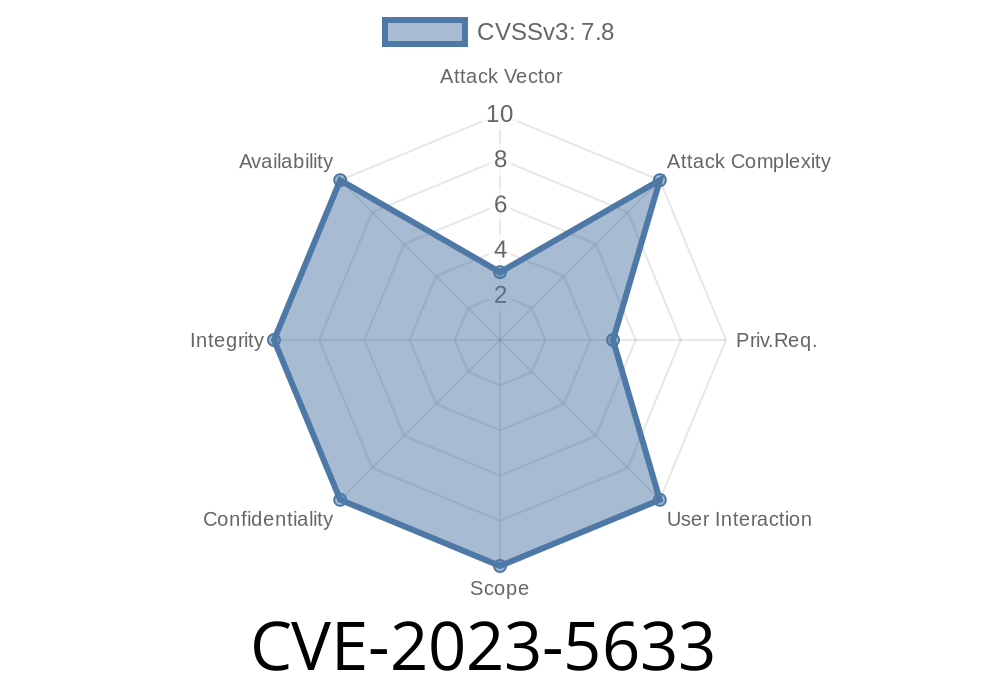In this deep-dive analysis, we are going to explore a use-after-free vulnerability discovered as a result of changes made due to CVE-2023-33951 and CVE-2023-33952 fixes in memory object handling. While this vulnerability specifically affects VMware guests with 3D acceleration enabled, it can potentially be exploited by a local, unprivileged user to escalate their privileges and compromise the system further.
Background on CVE-2023-33951 and CVE-2023-33952 Fixes
The CVE-2023-33951 and CVE-2023-33952 fixes were implemented to address security vulnerabilities related to the reference counting mechanism in memory objects. You can find the details about these vulnerabilities in the following official references:
- CVE-2023-33951
- CVE-2023-33952
These changes inadvertently resulted in the use-after-free flaw found in the way memory objects were handled when being used to store a surface.
Use-After-Free Flaw and Exploitation Details
The use-after-free vulnerability occurs due to improper reference counting of memory objects within the surface storage area. When a user application allocates and deallocates surfaces, the memory objects holding these surfaces can potentially be freed before the actual surface is detached correctly. This could lead to further exploitation of the freed memory for arbitrary code execution, and eventually, an unprivileged user could elevate their privileges on the system.
To demonstrate this vulnerability, here's a code snippet that outlines the incorrect reference count handling within the vulnerable function:
void vulnerable_function(surface_obj *surface) {
memory_obj *mem_obj = surface->mem_obj;
// Incorrect reference count decrement
mem_obj->ref_count--;
// The checks below may not properly account for the extra decrement,
// potentially leading to a use-after-free later.
if (mem_obj->ref_count == ) {
// Free the memory object
free(mem_obj);
// Failing to detach the surface could lead to further exploitation.
surface->mem_obj = NULL;
}
}
In order to exploit this use-after-free vulnerability, an attacker would first have to find a way to trigger the flawed reference counting mechanism while bypassing other security mechanisms in place. This may involve the use of heap spraying, heap massaging, or other memory manipulation techniques to force the allocator to return the freed memory for another allocation request, thus allowing for the injection and execution of arbitrary code.
Mitigation and Patch
To resolve this vulnerability, VMware has released a patch that corrects the reference counting issue by properly detaching the surface from the memory object before decrementing the reference count. The corrected code snippet would look like this:
void patched_function(surface_obj *surface) {
memory_obj *mem_obj = surface->mem_obj;
// Detach the surface from the memory object first
surface->mem_obj = NULL;
// Safely decrement the reference count
mem_obj->ref_count--;
if (mem_obj->ref_count == ) {
// Free the memory object
free(mem_obj);
}
}
You can find the official patch notes for this vulnerability at the following link
- VMware Security Advisory
To protect your systems, make sure to apply the patch provided by VMware and keep your systems up to date with the latest security updates.
Conclusion
This analysis has illustrated the use-after-free vulnerability introduced as a result of changes made for CVE-2023-33951 and CVE-2023-33952 in VMware guests with 3D acceleration. The flaw highlights the intricate dependencies within complex software systems and demonstrates how fixing one issue might inadvertently lead to the creation of another vulnerability.
As always, it is imperative to maintain an active security posture and keep your software up to date with the latest security patches in order to mitigate risks associated with these evolving threats.
Timeline
Published on: 10/23/2023 22:15:09 UTC
Last modified on: 01/10/2024 15:15:10 UTC
